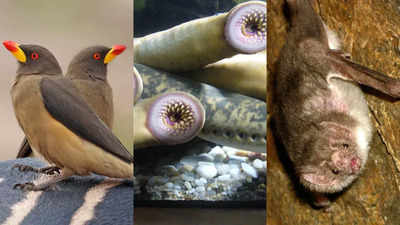
You’ve probably heard stories of insects sucking blood, but did you know some animals do it too? Known as hematophagous creaturesThese animals depend on blood to live. Familiar examples include vampire batvampire moths, vampire ground-finch, and even the oxpecker bird.
Blood is a nutrient-rich fluid, providing essential protein, iron, and other nutrients to fuel the animal. In some cases, hematophagy develops due to lack of food, because blood provides an important substitute. These animals have special features—such as sharp teeth, claws, or beaks—to extract blood from their hosts.
While insects like mosquitoes and ticks are common bloodsuckers, these animals also play an interesting role in nature’s survival strategies. Explore eight incredible creatures that feed on blood.
Why do animals suck blood?
Animals suck blood for a variety of reasons, mainly all related to survival:
A rich source of nutrients
Blood is a highly nutritious fluid, rich in protein, iron, and other essential nutrients. By consuming blood, the animal is able to access a source of essential nutrients needed for growth, reproduction, and survival. For example, vampire bats can sustain themselves by feeding on blood, which provides the energy they need for their activities.
Adaptation to resource scarcity
In some cases, blood feeding evolved as a response to environmental challenges, such as food shortages. For example, the vampire ground finch of the Galápagos Islands may start feeding on blood when other food sources like seeds or insects are not available. Blood is a surrogate source of hydration and sustenance, especially in dry or resource-poor environments.
Special feeding behavior
Many blood-sucking animals have evolved special physical traits to access blood efficiently. The sea lamprey has a mouth like a sucker with sharp teeth, allowing it to lock and extract blood from larger animals. In addition, vampire moths use specially adapted mouthparts to pierce their host’s skin.
Parasitic strategy
Some animals, for example Candiru fishusing a parasitic strategy. They exploit larger hosts by feeding on blood, benefiting from the host’s body as a constant and reliable source of food. This parasitic relationship allows candiru to bleed without the need to hunt or scavenge for food.
Evolutionary adaptation
The evolution of blood-sucking behavior is often driven by natural selection, where hematophagy confers a survival advantage. In the case of vampire bats, blood feeding is a specialized niche that reduces competition for other food sources. In addition, some species have developed mechanisms to ensure efficient feeding, such as anticoagulants in the saliva of vampire bats that maintain blood flow during feeding.
Animals that suck blood
Vampire bats
While only one subfamily of bats, the Desmodontinae, drink blood, these “vampire” bats are well known. They locate mammals or birds by detecting their breath, then use heat sensors to locate blood vessels near the skin. A single feeding can double the bat’s body weight. Interestingly, the saliva of Desmodus rotundus, a species that eats humans, contains anticoagulants used in the treatment of strokes.
Oxpecker
Native to Sub-Saharan Africa, the oxpecker feeds on parasites and blood. They often peck at wounds in cattle, drinking blood and sometimes worsening injuries, which can lead to infection.
Candiru fish
The notorious Candiru, a parasitic catfish from the Amazon, has a disturbing reputation for entering the human orifice, although this may be exaggerated. Usually, it swims to the gills of other fish to suck blood from the arteries, riding the host for miles while feeding.
Sea lamprey
Sea lampreys use their suction cup mouths, lined with rasping teeth and tongues, to trap fish and marine mammals, feeding on their blood. They are migratory creatures, often traveling between rivers and seas.
Moth vampire
Originally feeding on fruit, the vampire moth has evolved to feed on human blood. Using its hook-lined mouth, it pierces the skin and drinks, providing a glimpse into the evolution of blood-sucking insects.
Vampire ground-finch
Endemic to the Galápagos Islands, this finch usually feeds on seeds and insects but uses blood when resources are scarce. It feeds on the seabird’s blood vessels to drink, possibly a behavior that evolved from feeding on the bird’s parasites.
Leech
Leeches are notorious bloodsuckers, mostly found in freshwater environments. They attach to their hosts using suckers and secrete anticoagulants to keep the blood flowing while they feed. Medical leeches are even used in modern medicine to help blood circulation after surgery.
Lice
Fleas are parasitic insects that specialize in feeding on the blood of certain animals and also on certain parts of the host’s body. They have piercing mouthpieces that allow them to stick out and suck blood from selected areas. In humans, for example, head lice feed on blood from the scalp, while body lice tend to bite through the layers of clothing. Each tick species is highly adapted to its environment, becoming an effective and persistent parasite.
See also: 7 Animals that turn white to survive the winter




